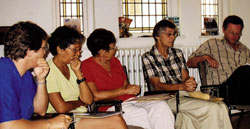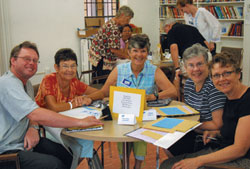Walking together in mission
Scarboro Lay Missioners gather for a time of discernment and decision-making looking to the future with hope

By Sharon Willan
October/November 2006
Return to Table of Contents
Print Article
This summer, 21 Scarboro lay missioners traveled from Guyana, Ecuador, China, Brazil, Thailand and Malawi to begin a process of discernment about their future in partnership with the priests of Scarboro Missions. The two-week process included storytelling, reviewing the history of lay missioners within Scarboro, introducing the partnership agreement, ratifying policies, and electing new leadership for the lay community. It was a daunting task and a shaping of history in this small but global community.

At Scarboro's two-week lay gathering this summer, missioners began by sharing their joys, sorrows, struggles and questions arising out of their overseas journey. This sharing laid the groundwork for a process of deep listening to the Spirit and to each other.
The process began with a day of sharing. Missioners each spoke of their mission ministries through symbols and storytelling. Sharing experiences of life in another culture – of joy, of pain, of questioning and of surrender – missioners laid the groundwork for a process of deep listening to the Spirit and to each other.
The room became holy ground in the telling of their stories. Clearly, the people they journeyed with and the relationships they developed in their mission countries had changed these missioners irrevocably. They had walked with peoples of different cultures and had truly listened to them.

Fr. Ken MacAulay
Fr. Ken MacAulay (inset) in his homily the next morning said, "To me there is a marked difference between hearing and listening. When we hear something, there is no effect on us. We hear a clap of thunder. Listening, however, is something quite different, and much more profound. To listen is to be humble. It means searching, even groping at times."
Missioners told stories about people, especially the women and children. Women, they said, carry the burden of family wholeness and support since the men are away finding work or have died, usually from HIV/AIDS-related illnesses. As a result, the family's simple life of subsistence farming that once supported them gives way to poverty and misery.
Many missioners live and journey with communities devastated by the HIV/AIDS pandemic. One missioner told of sitting with a dying child for days.
We heard stories of children living on the streets – many orphaned by AIDS or running from abusive homes. Drugs are prevalent and drug dealers lure children with promises of food and money. The children say that if they sniff glue or take drugs their hunger diminishes.
Young women on the streets often have tuberculosis. Lack of treatment results in the spread of this contagious disease. Young men without education and training become easily discouraged and lack hope as jobs are denied them.
Amidst this seeming hopelessness, missioners spoke of the great rejoicing when a young street person comes off drugs or finds a small job. There is also the joy of children who still live with their families and receive good meals, education and love. I was amazed to hear how these missioners work each day with poor and marginalized people and can see hope – a hope that sustains them to continue the journey. A deep spirituality and sense of commitment to their vocation, as well as their community spirit, nourishes and supports them at home and overseas – all are gift of the Spirit.
Symbols of the journey

The two-week process included reviewing the history of lay missioners within Scarboro, introducing the lay and priest partnership agreement, ratifying policies, and electing new leadership for the lay community.
Above L-R: Mike Hiebert, Georgina Phelan, Maxine Bell, Jean MacInnis and Anne Harty formed one of many small groups to facilitate the process.
After sharing their stories, missioners presented symbols representing their overseas walk with the people. From Ecuador and Brazil, we heard about Scarboro team efforts to bring communities together to work for their own betterment. A pocketknife that was knife, pliers, scissors and screwdriver in one, represented each team member's separate gifts, but all contributing to the whole.
"Only in working together and sharing our gifts is our presence felt and we are kept whole," said Mike Hiebert, a member of the Ecuador mission team.
An Indigenous hat was the symbol for Scarboro missioner Julia Duarte whose family and passion for the people of Ecuador, her native country, motivated her in this life-giving work.
Bev Trach, missioned to Fortaleza, Brazil, presented a macram. bracelet representing the different threads in her mission: street kids, the cancer hospital, her small neighbourhood, and Our Lady's Missionaries in Fortaleza who are happy to have Bev sharing life and ministry with them.
The Malawi team expressed their thoughts about loneliness in mission and about the strain of seeing people hungry for both food and liberation from extreme poverty. A tall wooden carving of an African woman holding a basket on her head symbolized that women carry the burden of poverty on their backs.
Ray Vantomme praised the women with whom he works for their contribution to Malawian society. A woman Ray knew had taken the head position at the prison. When a guard hurt a female prisoner, the guard was immediately let go. This sent a message to the rest of the guards and the violence lessened. Ray spoke of grandmothers who become heads of households when their children die of AIDS. These women now teach the next generation.
Mary Olenick presented a trophy she had carved for the Ultimate Frisbee game that a young Canadian visitor introduced to Malawian young people in the community where Mary works. For Mary, the trophy symbolizes the triumph of the spirit of the people.
What can a piece of corn tell us? Maize is the staple food of Malawi, and Barbara Michie spoke of learning to live according to the planting and harvesting seasons. Barbara watches the people plant maize seed during the dry season. And like them, she watches the skies daily for signs of cloud during the rainy season. When it rains too hard she goes out with the people to replant the seedlings, and when the sun dries the plants she helps water them. Barbara's symbol – the maize and a poster of a maize seed – spoke of hope and a burgeoning vision for Malawi, a famine-ravished nation.
A calabash and a crafted necklace expressed mission in Guyana. The necklace is a symbol of love for the Amerindians Maxine Bell accompanies. Teaching the women knitting and crocheting using their own plant materials taught her that building on the traditional knowledge of the Indigenous people is vital in helping them to become more self-sufficient.
Kate O'Donnell explained that a calabash is a large fruit about the size of a human head. Dried and hollowed out, the fruit can be used for any number of purposes. Kate smiled as she expressed a willingness to be open to the love of God for any purpose.
China and Thailand are an adventure of language, customs and different religions. Susan Keays and Georgina and Paddy Phelan told of recognizing the presence of God among the Thai people. Georgina's symbol, a woven woolen stole, spoke of her friendship with a Thai woman. Paddy chose crafts as his symbol since the adults and children living at the HIV/AIDS centre where Paddy and Georgina work create handicrafts for sale and to help take their minds from their illness and pain.
Susan's simple coffee cup reminded her that the cup of life is always changing. Many hill tribe children attend school at the education centre where Susan worked, their lives changing as a result of their learning.
Cynthia Chu used a keychain to illustrate her opening to God and to the people of China. There, presence is the mission way, since the Chinese authorities do not permit publicly speaking of religious beliefs outside of church.
In Canada two married couples and a lay woman spent four months at Scarboro Missions preparing to go overseas. Their symbols told of long discernment and a desire to do something more with their lives, eventually leading them to Scarboro to walk as missioners among the poor in another land and culture.
Four people missioned in Canada and working at Scarboro's central-house spoke of their longing to return overseas. Jean and John MacInnis had served in the Guyana mission prior to serving as coordinators of Scarboro's Lay Mission Office in Canada. Jean presented a DVD of the movie, March of the Penguins, which symbolized for her the importance of self-sacrifice, relationships and role-sharing in a community. For Jean, these values are the focus of all mission, whether at home or overseas.
John held up a clay plate showing two footsteps, a symbol of God's loving care in carrying him as well as the whole Scarboro community forward.
Louise Malnachuk expressed gratitude for her mission vocation and held up a hat representing the many hats she wears in serving the members of her mission community here in Canada. She felt blessed to walk among them after more than 15 years of mission in China.

Karen Van Loon
After serving in Brazil, Karen Van Loon now coordinates Scarboro's Justice and Peace office in Canada. Her symbol – a plastic toy boat filled with toy figures – spoke of her dual commitment to her husband and children as well as to her Scarboro community. Karen's passion for justice moves her mission vocation.
What an honour for me to have been present to experience the depth of emotions, tears and laughter on this day of intimate sharing. Working with this community of priests and lay women and men for the past five years has been a privilege and blessing. The two-week gathering only broadened the vision I have witnessed – a vision of a Spirit-led community committed to walking into the future with each other alongside the struggling peoples of the world.
Sharon Willan is a trained spiritual director in Franciscan Spirituality and worked as Program Associate in the Scarboro Lay Mission program.
Return to Table of Contents
Print Article